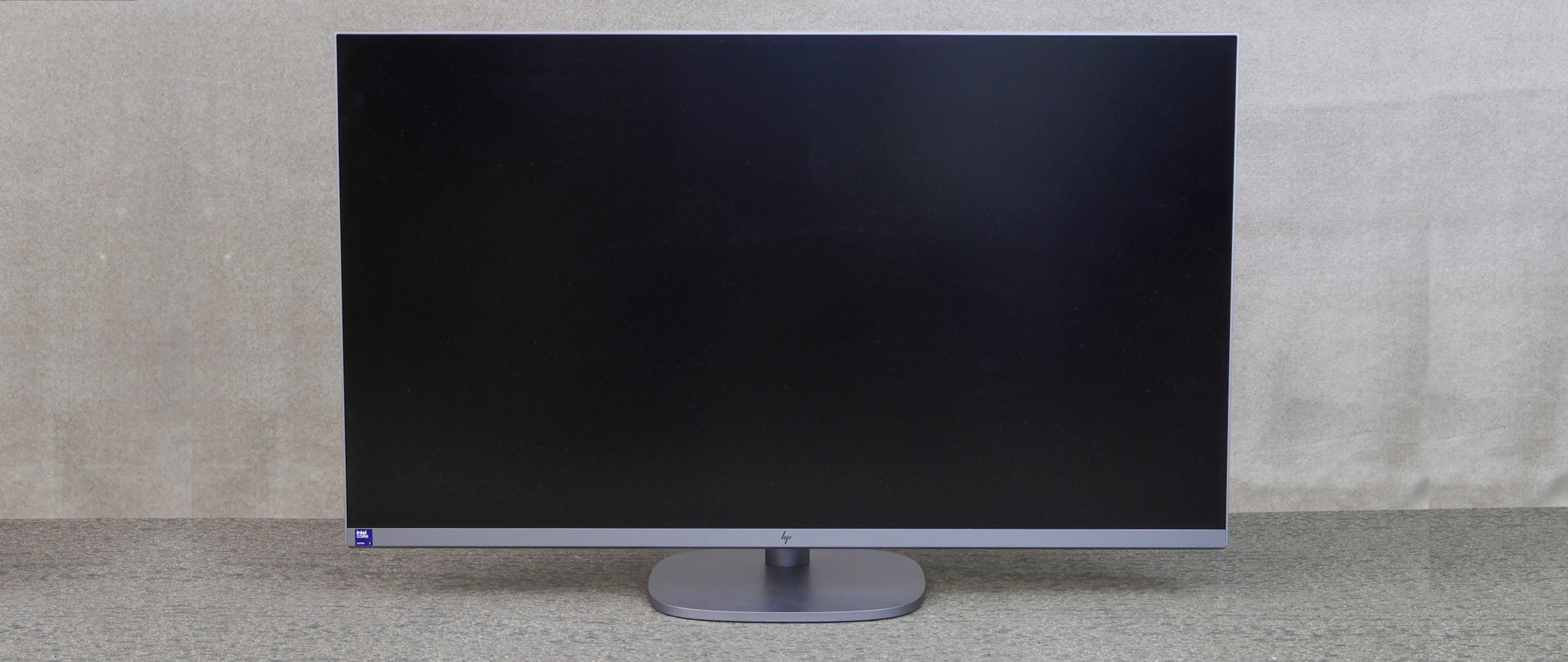Tom's Guide Verdict
The OmniStudio X makes a good home office desktop or base station for commuters, and it can serve as a single screen for both computing and TV for those on a tight budget. But it won't replace your main content creation or gaming system.
Pros
- +
Fully customizable
- +
Excellent display color accuracy
- +
Lots of easily reachable connection ports
- +
Can act as an external monitor or dock for other devices
Cons
- -
Included keyboard and mouse are poor
- -
Webcam image quality is mediocre
- -
Not great for gaming
Why you can trust Tom's Guide
The OmniStudio X ($1,450 to start) is HP's newest line of all-in-one desktops, and they're intended to entice AI-curious customers by being tailor-made for AI work.
The OmniStudio X 32 is the largest model thanks to its 31.5-inch 4K display, and it's designed support and accelerate as many AI tasks as possible. The CPU, integrated GPU and available add-on GPU all have AI acceleration hardware. The pop-up webcam uses HP's Polycam Pro software, allowing various visual and audio filters for your teleconference needs.
HP goes so far to claim the OmniStudio X can be the central hub of your digital life. And while you'll want to read this HP OmniStudio X review before you decide for yourself, it's not an unfounded claim, as the OmniStudio X 32 hosts a USB hub with multiple input/output ports and can serve not only as your primary computer, but also as a display for your gaming console and a dock/external screen for your laptop. In fact, it might just be the best all-in-one for folks seeking a no-nonsense productivity machine.
However, there are some key strengths and weaknesses you should know about before you purchase one, and I'll walk you through them in this HP OmniStudio X 32 review.
HP Omnistudio X 32 review: Cheat sheet
- What is it? The Omni Studio X is an AIO desktop designed to focus on AI tasks instead of brute force computing.
- Who is it for? Freelancers, prosumers, and anyone that wants an AI-focused computer with minimal clutter on their desk.
- What does it cost? The MSRP for base models sold on HP's website starts around $1400 while upgraded configurations are over $2700. The review model retails for $1979.99 at this time.
- What’s good about it? Users can order a completely custom configuration; it also functions well as a laptop dock and external display for other devices.
- What’s not so good? Performance is middling, and the included keyboard and mouse are pretty bad.
HP Omnistudio X 32 review: Specs
| Row 0 - Cell 0 | HP OmniStudio X 32 |
Starting price | $1,499 |
CPU | Intel Core Ultra 5 125H - Ultra 7 155H |
GPU | Integrated graphics or Nvidia RTX 4050 GPU |
Display | 31.5-inch 4K UHD (3840 x 2160) IPS |
Memory | 16-32GB DDR5-5600 |
Storage | 256GB - 2TB SSD |
Ports | Side: 1x USB-C, 2x USB-A; Rear: 1x USB-C, 2x USB-A, RJ-45, DisplayPort 1.4, 1x HDMI out, 1x HDMI in |
Webcam | 12MP w/ Desk View support |
Size | 28.1 x 7.8 x 22.2 inches |
Weight | 21.61 pounds |
The OmniStudio X is an oddity in the desktop AIO space. Many competing desktops usually have a few available pre-built configurations. Those that do offer customization often restrict component selection on another, such as requiring an upgraded CPU in order to get a higher RAM capacity or stronger GPU. However, HP allows consumers to independently configure the OS, CPU, RAM, storage, GPU, and even the Wi-Fi with no restrictions.
That's not to say you have unlimited options. As this is a slim AIO, the processor and GPU are limited by the design's limited cooling abilities compared to a full desktop case. This is essentially a laptop bolted to the back of a large display, as are most AIOs. Choice of CPU is limited to two options, and graphics are either the integrated Intel Arc or an add-on RTX 4050. System RAM can be 16 GB or 32 GB, but system storage can be anywhere from 256 GB to 2 TB. HP also offers a Wi-Fi 7 card for an additional $10.
The unit HP sent us for review isn't the highest possible configuration, but it is close. The CPU is an Intel Ultra 7 155H with a 1 TB NVMe storage drive and 32 GB DDR5-5600 RAM. The integrated Arc graphics are bolstered with an RTX 4050 and wireless networking is handled by a Realtek Wi-Fi 6 / Bluetooth 5.3 combo card. This specific SKU is a Best Buy exclusive and retails for $1979.99, though you can configure a similar online at HP's site.
HP Omnistudio X 32 review: The ups
There's a lot to like about the HP Omnistudio 32 X, and there are a few specific strengths I think you should know.
Fully customizable, a rarity among AIOs
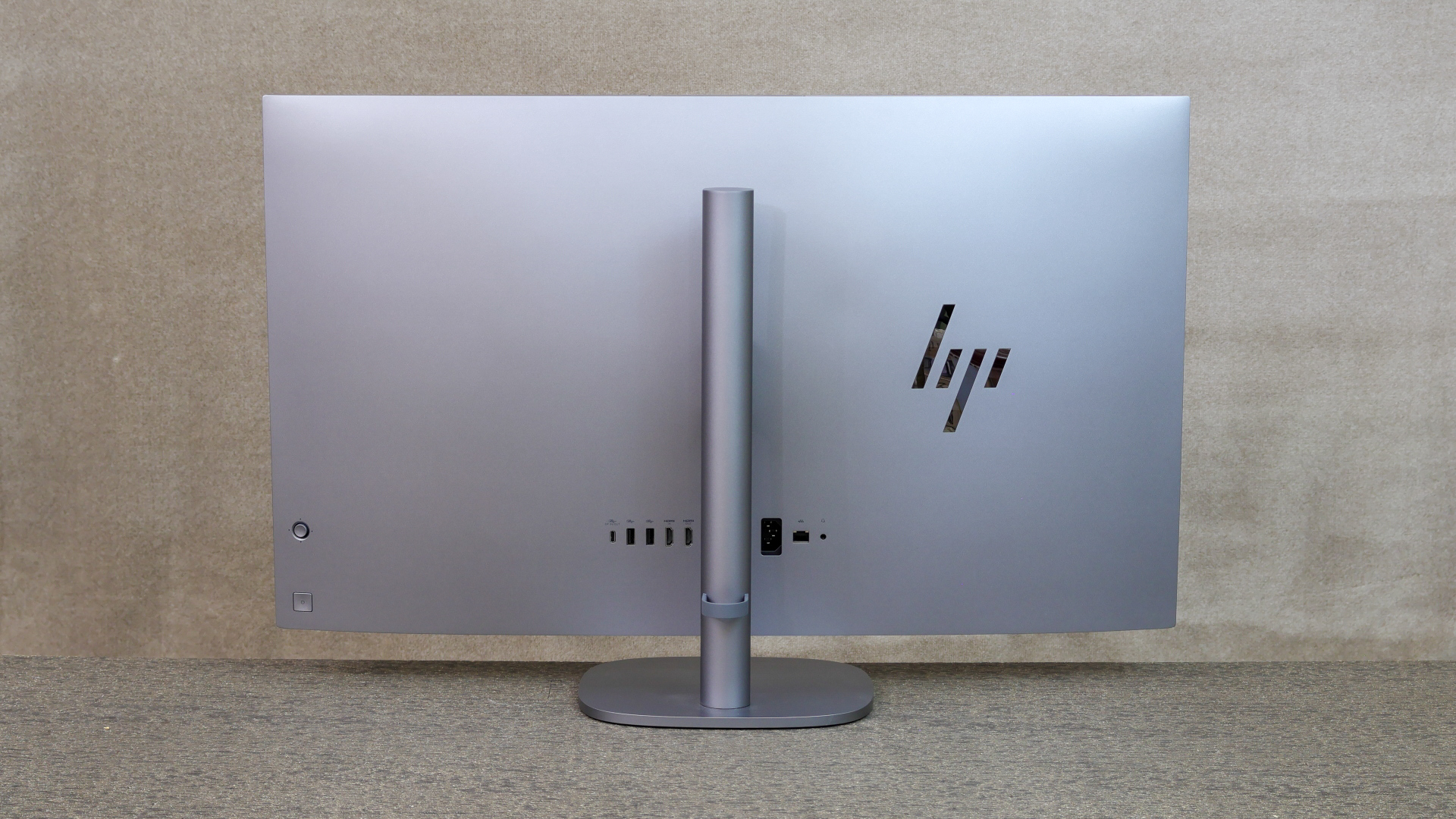
Being able to select each hardware component for the desktop independently without restricting options for part X because you chose the lower version of part Y is refreshing. HP should be applauded for this decision as it makes the desktop feel truly custom and doesn't penalize customers by forcing them to pay for hardware they don't need.
The OmniStudio X doesn't take up much room on your desk, the same as most AIOs. The stand base is a rounded rectangle, roughly 8 x 9 inches. The stand has 100 mm of up/down travel to set the monitor to your preferred viewing level and can tilt backward. Controls for the computer are minimal, but perfectly sufficient. The power button is on the back corner of the unit. Just above it is a four-way joystick for controlling the monitor functions like brightness and volume.
Excellent display color accuracy
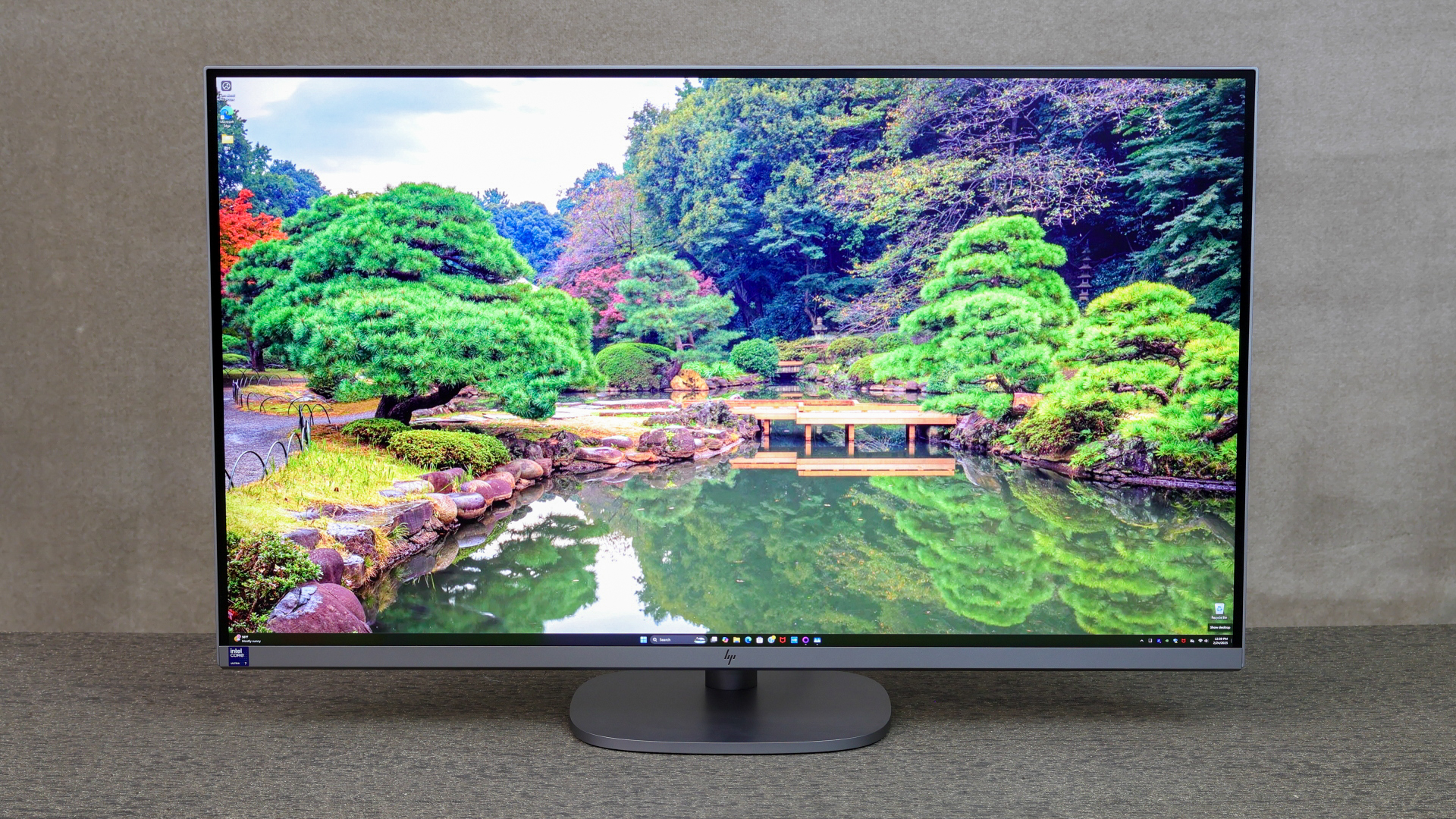
The display is color calibrated from the factory and has fantastic accuracy. The default P3 profile locks the display to 100% of the DCI-P3 gamut with a Delta-E of only 0.33. Presets for the sRGB and related BT.709 color spaces are also available. Both feature an even lower Delta-E under 0.3 and 100% coverage of the sRGB gamut. In SDR mode, the screen averages over 580 nits in these three modes, surpassing HP's claim of 550 nits. The panel is IMAX Enhanced and supports HDR 600, outputting 720 nits or greater in HDR mode.
The included keyboard and mouse are wireless. The receiver dongle is tucked in the underside of the frame toward the right side. It's wrapped in a rubber grommet, and you can replace it with another USB type-A dongle of similar size. With Wi-Fi and Bluetooth also on board, the only cable necessary to use the OmniStudio X is the power cord. Smartly, HP used an internal power supply with a standard 3-prong power cable instead of a large power brick.
Of course, most people are likely to connect at least a few peripherals to their desktop. A trio of 10 Gbps USB ports (one type-C and two type-A) are on the base of the stand, allowing quick connections for things like thumb drives and card readers so you don't need blindly fumble around at the back of the computer. These ports connect to the main unit through a type-C connector hidden inside the mount between the stand and the main unit. For more permanent peripherals, three USB ports are on the back of the main unit, two 10 Gbps type-A ports and one 20 Gbps type-C port. A 2.5 Gbps Ethernet jack and 3.5 mm headset connector are also available.
Two HDMI ports (one input, one output) allow you to connect an additional display, or to use the OmniStudio X as an external monitor for a gaming console, streaming box, or other computer. It also supports Intel Unison for wireless display connectivity. Further, the type-C port also supports DisplayPort over USB, both input and output, and has USB Power Delivery with limited USB device sharing. This means the OmniStudio X can act as a laptop dock and external display with only a single cable (a type-C to type-C is also provided in the box). Even more, the webcam and USB port used for the keyboard/mouse dongle will also be shared over the link to the laptop. The OmniStudio X itself does not need to be booted up and running for the external monitor or laptop dock features to operate.
Can act as an external monitor
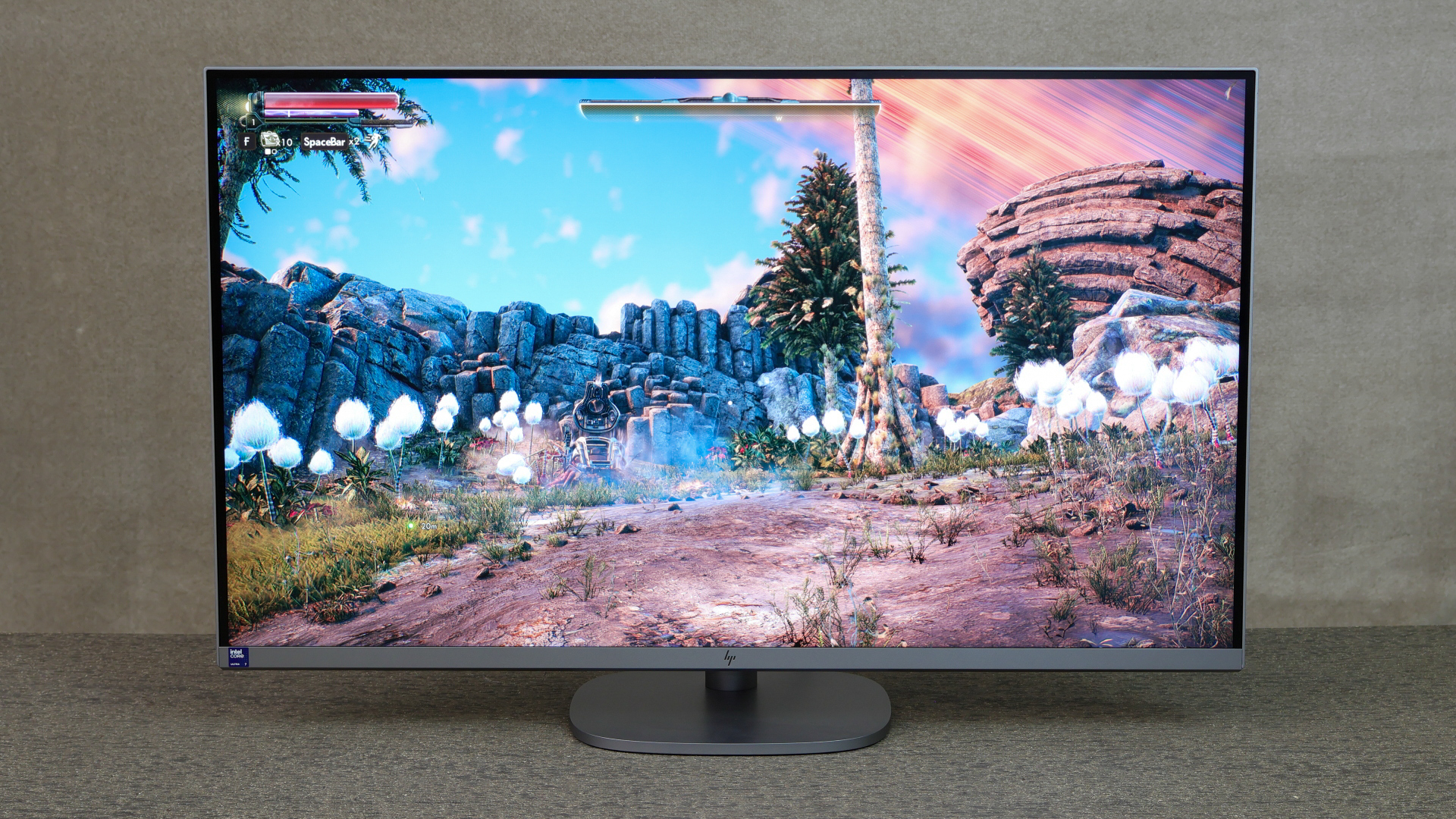
Using one computer to act as a dock for a second computer may sound like a niche use-case, and an expensive one at that. However, it makes a lot of sense for those with work-issued laptops, especially if you need special VPN software to connect to your work. On days you're working remote, or have after-hours meetings, you can simply connect that work laptop to you home AIO. That way you get the productivity benefits of a larger display and full-size keyboard/mouse without worrying about mirroring your work settings and files to your home computer.
The 5.2 MP webcam has a native 2880x1800 resolution and is contained in a retractable housing on top of the computer frame. It can capture video at a maximum of 2560x1440 at 30fps, but it can't record at 60 fps, even at lower resolutions. Using the Poly Camera Pro software expands the camera's capabilities somewhat. It has the usual effects and filters, like color correction, auto tracking, and background replacement. It also can use upscaling algorithms to increase video resolution and even framerate.
HP Omnistudio X 32 review: The downs
While I like a lot of things about the HP Omnistudio 32 X, there are also some key weaknesses I think you should know about before you buy.
Mediocre webcam
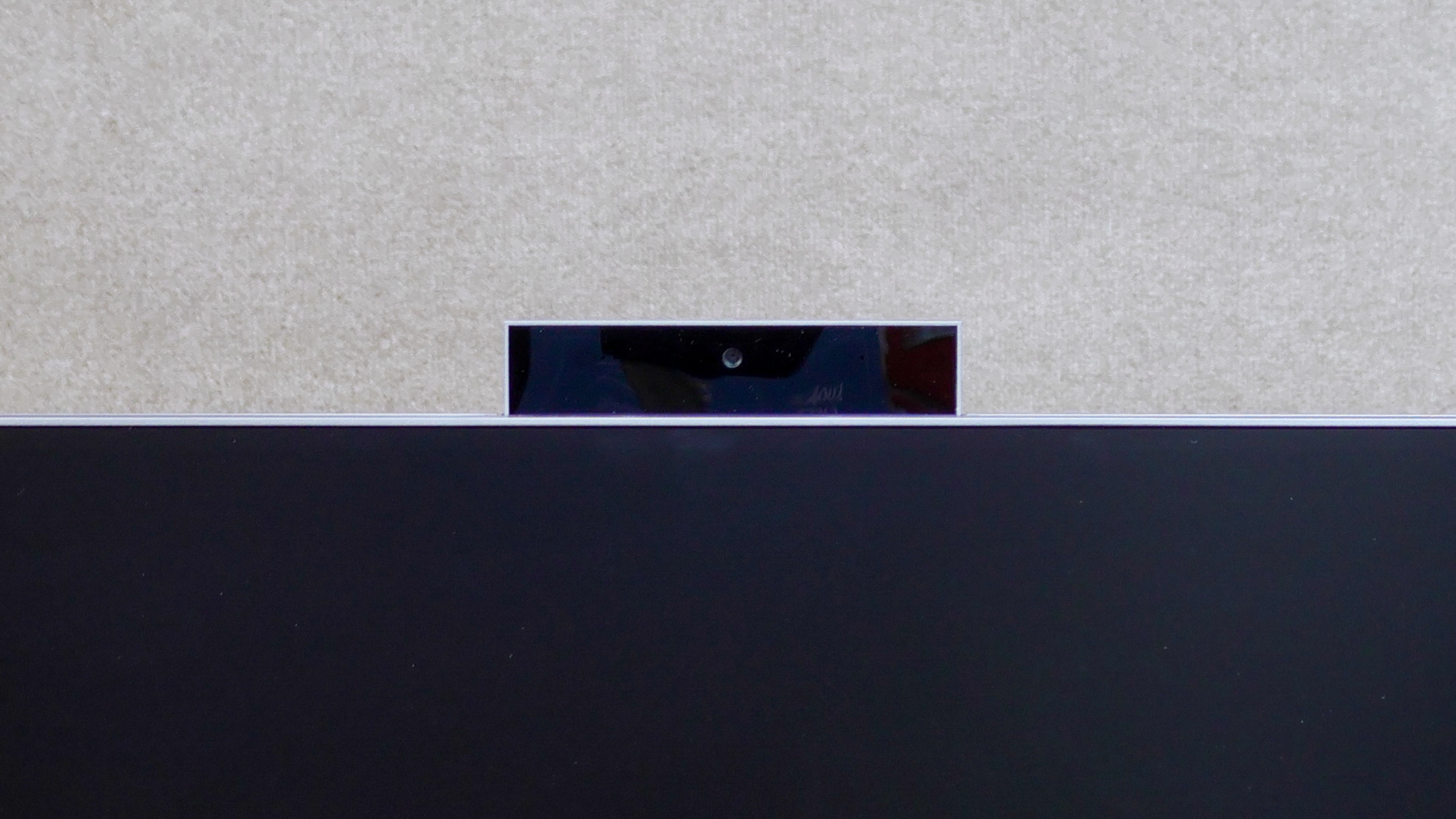
Though the camera does have various upscaling utilities, resulting image quality is still not great. Edges are soft and background noise is still an issue. Using Poly Camera Pro to record faster than 30 fps only duplicates frames; it won't generate and insert new frames. While Poly Camera Pro may give you a few more options for the integrated webcam, it won't cheat physics. Better lenses and larger sensors from add-on cameras will always result in a clearer picture with less noise and visual artifacts.
As the bulk of teleconferences and video chats still happen at 720p with heavy compression, this isn't a problem for many people. But it does feel like HP is overstating the capabilities of the camera and software, especially compared to what the iMac offers.
Included keyboard and mouse are poor
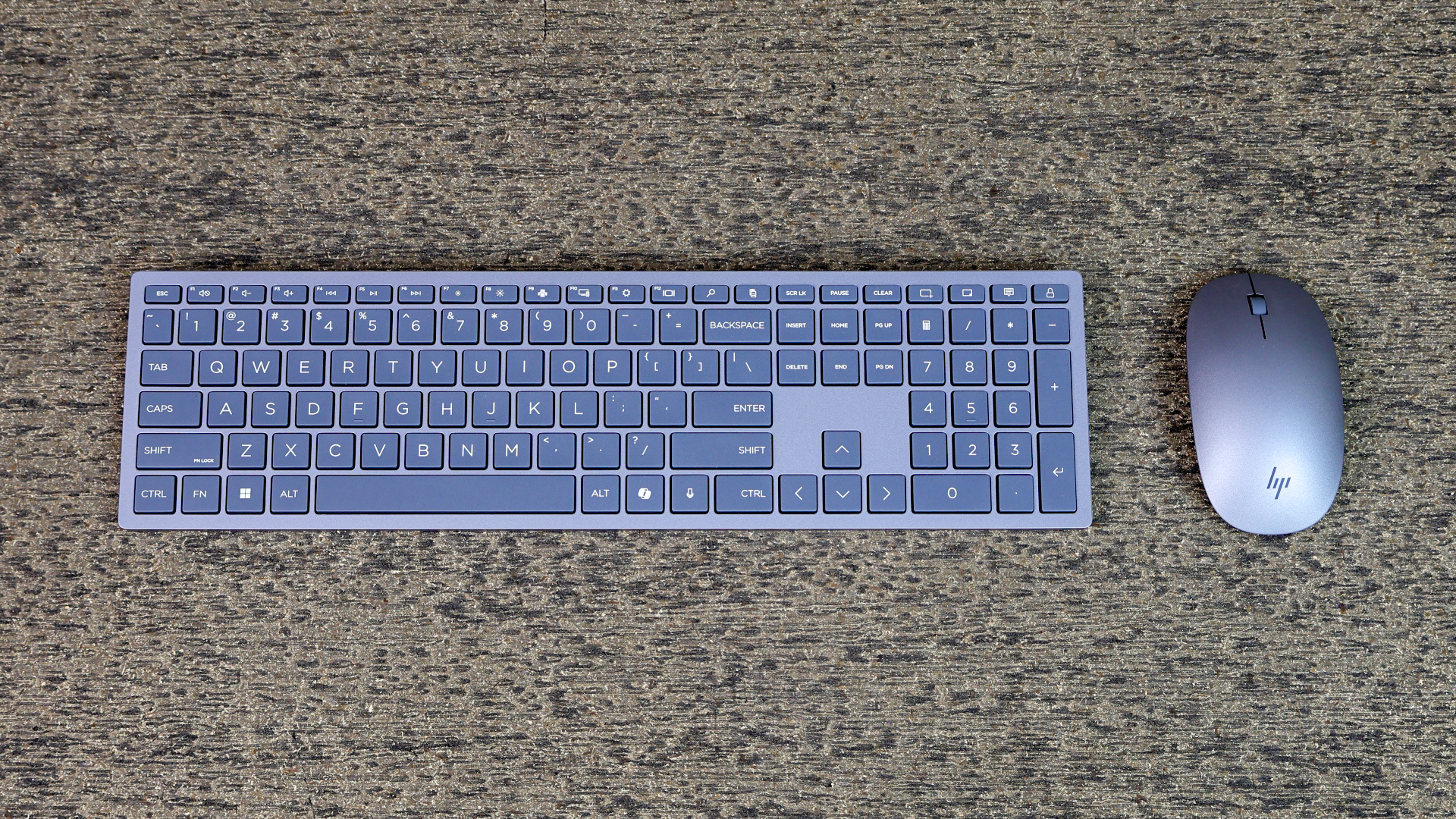
By far, the biggest let down of the OmniStudio X is the included mouse and keyboard. Both are powered by two AA batteries, which are included in the box. The mouse is a typical example of pointing devices packed with basic desktops from the big manufacturers. It has three buttons, a scroll wheel, and no other noteworthy features. The mouse sits quite low, despite the rounded top, and doesn't fill your hand. It's serviceable, but not something most people would want to use for a significant portion of the workday.
The keyboard frame and structure feel strong and secure. However, it's a fixed angle without any adjustment. The key layout is normal with the lone exception being the absence of a NumLock key. In its place is a dedicated calculator key, which makes good sense as few people use the tenkey as cursors or for document navigation. The feel of the keyboard is similar to many laptop keyboards. The throw is short and you essentially have to bottom out each key to reach activation. There is a tactile bump, but it lasts the entire keystroke, lending to a mushy feel. The worst part is the keycap texture. The key labels are printed quite thick, raising the labels above the surface of the keys and giving each a different texture.
Those wanting to replace the keyboard/mouse with more suitable models can easily do so. If you want to keep using the same hidden USB port to share with your laptop over the docking cable, it will need to be a combo unit where both devices connect over the same cable or dongle.
The stand and ergonomics could also be improved. The stand doesn't pivot side-to-side, which is a minor complaint. A bigger problem is the monitor will not tilt at a downward angle. It can tilt 15° upward, but the farthest down it will go is a few degrees back from vertical. If you only use it from a position where your head is well above the monitor's centerline, this isn't a problem. But HP markets this as a central hub as well. If you're using it to watch TV or for a game console and you're reclining back, you're not getting the best angle of the display. It's an IPS panel, so viewing it off angle isn't a problem for color accuracy, but there's no reason the monitor shouldn't be able to tilt at least a little downward. It would also be nice if the headphone jack was on the bottom or side, where it's easier to reach, rather than on the back.
Not great for gaming
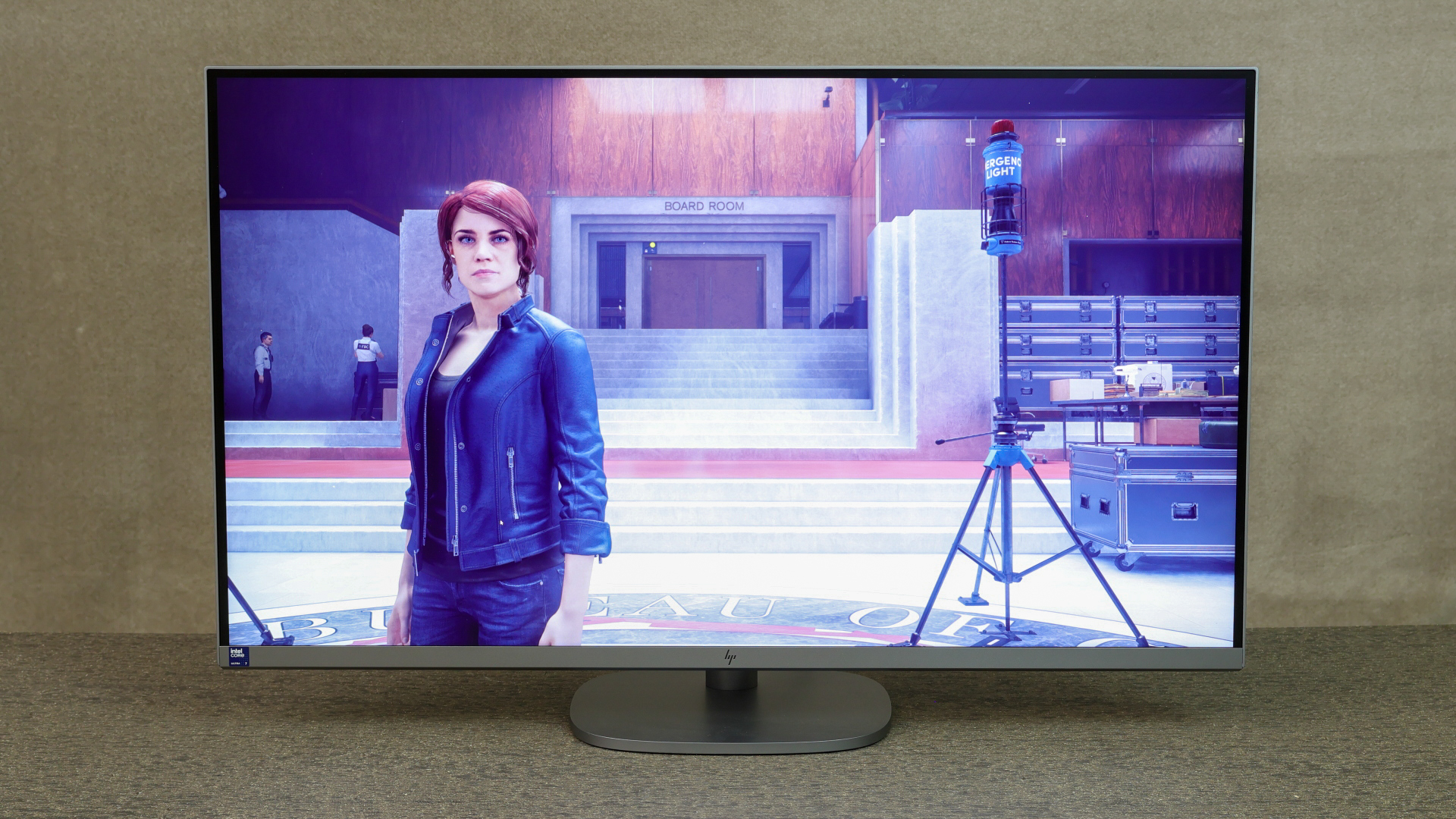
Speaking of entertainment use, the system has considerable limitations, especially in gaming. Admittedly, the OmniStudio X is not marketed as a gaming machine, so this may be irrelevant to some end-users. The optional RTX 4050 can serve as an adequate accelerator for AI and video compression tasks, but it's woefully underpowered for any kind of gaming at native 4K.
The lone title in our benchmark suite which could maintain a minimum of 30 fps at 4K was DiRT 5. AC: Mirage plays at 26 fps, so adjusting to lower detail settings might be enough to get it playable. The rest were either slideshows or complete no-gos. Many of our benchmarking titles wouldn't even run at 4K resolution. The card's 6 GB of VRAM is simply not enough to load in the higher-res assets and textures.
That's not to say you can't play games on the OmniStudio X; you just need to be more selective about it. Dropping down to 1080p or using DLSS will both provide much better framerates. The trade-off is of course image quality after upscaling, which can vary depending on the game. At 1080p, AC: Mirage, Borderlands 3, and Far Cry 6 can maintain 60fps for much smoother gameplay, while Metro on High settings and Red Ded Redemption 2 at Medium detail are a very playable 54 fps and 44 fps, respectively. These scores pale in comparison to the two AtomMan machines, but no one expects an RTX 4050 to keep pace with an RTX 4070 or RX 7600M XT.
But even dropping to lower resolutions isn't a guaranteed solution. The OmniStudio X can run into problems with more demanding games or higher detail settings. At 1080p, Cyberpunk 2077 is still under 20 fps and Red Dead Redemption 2 won't run when using Ultra details. Black Myth: Wukong throws warnings regardless of graphical settings due to limited VRAM.
The OmniStudio X would greatly benefit if its display supported some form of variable refresh rate, but sadly this isn't the case. Smoothing out gameplay in the 45 – 60 fps range is arguably the place VRR makes the most noticeable improvement in gaming. Along with VRR, a higher refresh rate would make the OmniStudio X more appealing to be used as an external monitor for game consoles or a gaming laptop.
HP Omnistudio X 32 review: iMac M4 vs. HP Omnistudio X 32
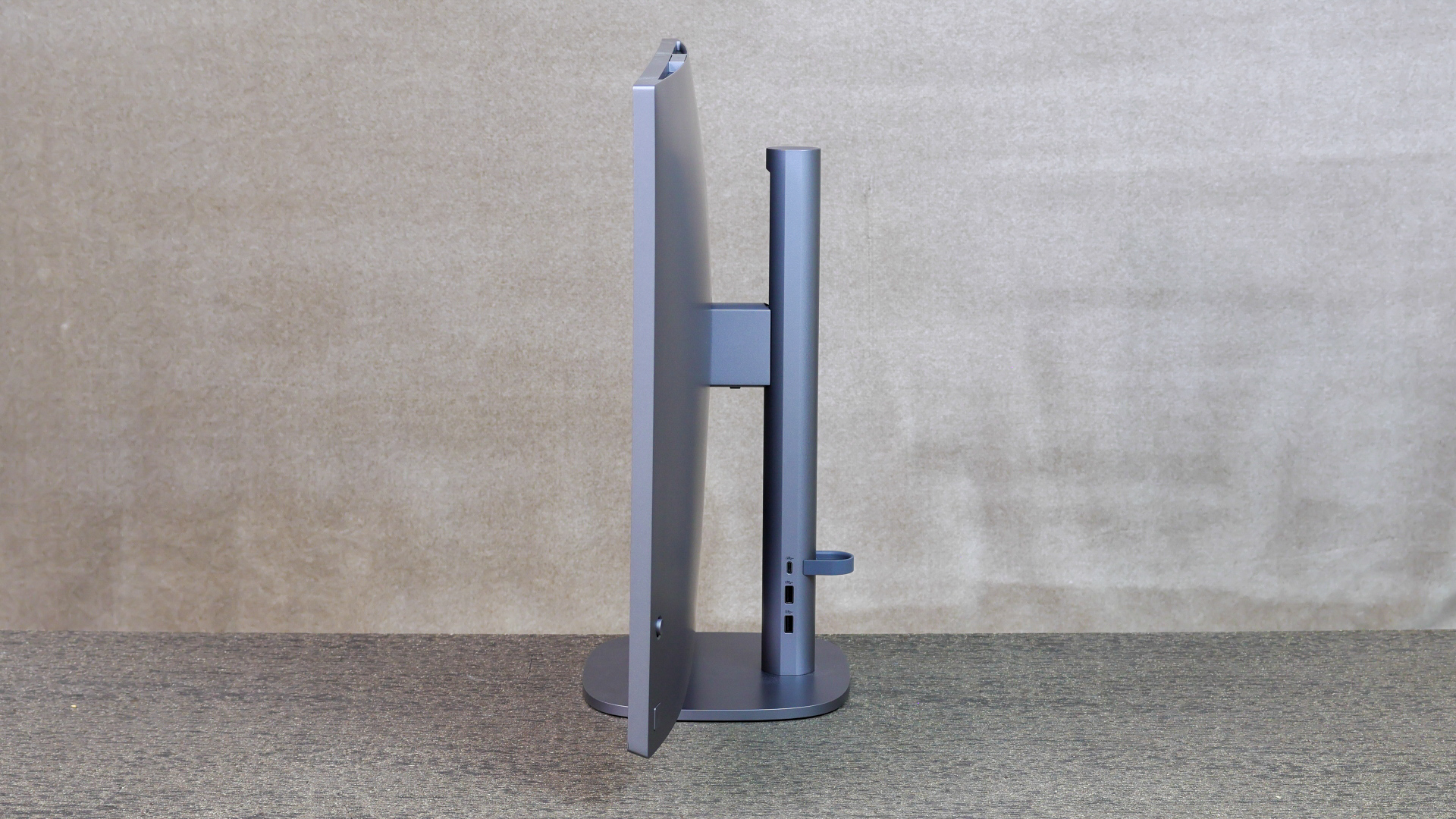
The iMac M4 makes an interesting performance comparison to the OmniStudio X, so much so that I wanted to dig into our lab test results in detail to show you how the two compare. In some tests the HP wins out, but in most Apple's M4 chip takes the lead.
The iMac M4 has fewer total cores than the Core Ultra 7 in our OmniStudio X, but it's also a different microarchitecture (ARM vs x86-64) so software optimizations and different workload types can have wildly different results between the two. The iMac's display is much smaller than the OmniStudio X at only 24", though it does have a higher resolution. An iMac equipped with the same 1 TB storage and 32 GB RAM as our OmniStudio X review sample also costs $300 more.
If you're willing to consider mini PCs instead of only AIO desktops, AtomMan has two very interesting competitors. AtomMan offers the G7 Ti with an i7 or i9 CPU and RTX 4070 GPU, while their G7 PT has a Ryzen 9 CPU and RX 7600M XT GPU. Both offer far stronger CPUs and GPUs than either the OmniStudio X or iMac. And if you add in the cost of a separate 32" 4K display, both are around the $2000 mark.
| Row 0 - Cell 0 | HP Omnistudio X 32 | iMac M4 | iMac M3 |
Geekbench 6 (single-core) | 2,133 | 3,646 | 2,235 |
Geekbench 6 (multi-core) | 12,128 | 14,724 | 10,745 |
The cooling system and power envelope of the OmniStudio X limit how hard the CPU can work. Under light workloads, the CPU stays between 3.8 – 4.0 GHz but never reaches the max specified 4.8 GHz turbo clock rate. Under heavy loads, sustained clock rates drop to around 2.4 GHz due to increased heat generation. Using torture tests like Prime95 drops the clock even more to 1.9 GHz. But even under full load, the fans aren't particularly loud or annoying. It's obvious the stock cooling profile, and resulting clock rates, of the OmniStudio X focuses more on quiet operation rather than maximum performance. It doesn't feel sluggish in normal use, but it does trail the two G7 computers in nearly every computing benchmark.
| Row 0 - Cell 0 | HP Omnistudio X 32 | iMac M4 |
BlackMagic Disk Speed (read) | 2,759.9 | 2,895.2 |
BlackMagic Disk Speed (write) | 2,455.8 | 3,045.6 |
The OmniStudio X has the slowest storage drive in read and write speeds of the group. It also lags behind the other three in the GeekBench 6.3 and CrossMark tests. It does a little better in the AI benchmarks. When considering just the CPU, integrated graphics, and any NPU present, the OmniStudio X trades blows with the two AtomMan computers, but it's significantly behind the iMac. However, Apple doesn't offer the iMac with a discrete GPU. As such, the OmniStudio X takes a decisive lead over the iMac when it can leverage its Nvidia hardware for AI tasks. The two G7s, with their stronger GPUs, are on a completely different level.
| Row 0 - Cell 0 | HP Omnistudio X 32 | iMac M4 |
Photoshop | 6,085 | 10,419 |
Premiere Pro | 7,102 | 4,660 |
The Adobe tests show the strengths of the different subsystems. The Photoshop workload is mostly CPU dependent, though it does have some AI and GPU accelerated portions. With the slower storage, it's no surprise the OmniStudio X is slower than the iMac in file open speed. It also appears the M4 chip is better tailored for Photoshop filters and tasks, because the iMac earns a higher score and completes the benchmark in half the time.
| Row 0 - Cell 0 | HP Omnistudio X 32 | iMac M4 |
Photoshop | 6,085 | 10,419 |
Premiere Pro | 7,102 | 4,660 |
However, video encoding tasks are faster on the OmniStudio X than the iMac. HandBrake is strictly software encoding on the CPU, and so too is Premiere Pro, though the latter does allow hardware acceleration on a couple passes. Here, the Core Ultra 7 asserts a small but notable lead over the M4 with some help from Nvidia's phenomenal hardware acceleration for H.264 and HEVC codecs.
HP Omnistudio X 32 review: Verdict

That the OmniStudio X doesn't have strong gaming chops doesn't matter much to the target audience. Family AIO desktops aren't meant to be primary gaming systems. Being limited to a 60 Hz panel with no VRR is a larger issue, potentially a deal breaker, for end-users that expect the OmniStudio X to pull double duty.
Despite the previous paragraphs, it's important to note the OmniStudio X is not a slow machine. In normal daily use, it's not sluggish or unresponsive. Benchmark tests are designed to stress a machine beyond what most consumers will experience in daily use. Just because you wouldn't use the OmniStudio X as your primary 3D and video render farm does not make it a bad computer for basic home and office use.
Like most consumer goods, increasing performance in one aspect requires some form of trade-off elsewhere. Higher computing performance requires more expensive parts and, usually, higher electrical consumption and heat output. More heat requires more cooling. More cooling most often means more airflow. More airflow means more volume, more noise, or both. There's no such thing as a free lunch.
HP designed the OmniStudio X to achieve high work output by accelerating AI tasks, not through brute force CPU performance. The upside to this is a smaller, quieter desktop for a mid-budget price that can punch above its weight in certain situations. The downside is that total performance and work output will suffer if AI acceleration isn't or can't be utilized. If the software you use doesn't use AI algorithms, or uses methods that aren't directly supported by the OmniStudio's hardware, then it won't perform any better than a mid-level laptop.
Eric started gaming young in life, crashing MS Flight Simulator planes at the age of three on a suped-up PCjr in the Microsoft test labs. Much of high school was spent in the computer labs, building computers from spare parts, writing programs on his TI calculator to do his physics and calculus homework, and helping the business teacher run multiplayer StarCraft games on the school network. Eric has over 15 years’ experience in databases, programming, quality assurance, and testing methodology. He has reviewed tech and computer hardware since 2015 for Tom’s Hardware and other outlets.
You must confirm your public display name before commenting
Please logout and then login again, you will then be prompted to enter your display name.
